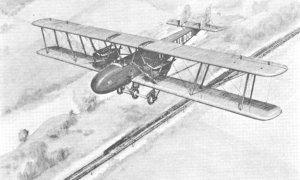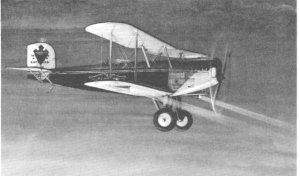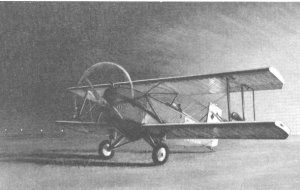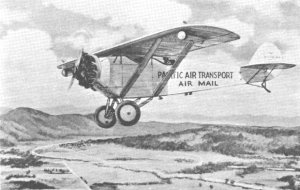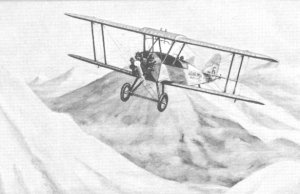
|
|
The lighted Airway
History: Pages
1, 2,
3
| During the spring and summer of 1923, work on a
lighted airway between Cheyenne, Wyo., and Chicago, Ill., was being pushed
forward with a view to carrying out certain experiments to determine
whether cross-country night flying on a regular schedule was possible, and
whether a through transcontinental air mail service between New York and
San Francisco could be regularly maintained. This was certainly a huge
undertaking, as up to this time very little night flying had been done
and, of course, there were no lighted airways in existence. The U. S. Army Air Service had carried on some experiments and developed certain necessary equipment, but had attempted very little regular scheduled cross-country night flying. The Army obligingly placed at the disposal of the Post Office Department all the knowledge they had obtained from their experiments. Splendid cooperation was had at the hands of manufacturers of illuminating equipment of various kinds. The General Electric Company, the American Gas Accumulator Company, and the Sperry Instrument Company were particularly thorough in the assistance rendered. Beacon lights were installed between Chicago and Cheyenne, planes equipped with landing lights, emergency fields prepared, lighted and marked, and terminal fields lighted. Pilots were given an opportunity to make practice night flights. All arrangements were completed as planned, however, and in August 1923, a regular schedule was flown between New York and San Francisco for a period of four days, that part of the route between Chicago and Cheyenne being flown at night. The best time eastbound on any of the four days was 26 hours and 14 minutes, and the best time made westbound was 29 hours and 38 minutes. It may be stated, however, that better time can generally be made on eastbound trips due to the fact that the prevailing winds are from the west. The result of the test was so satisfactory, being 100 per cent perfect, that operation of a transcontinental service on a similar schedule, the first 30 days to be a trial, was decided upon. It was also decided to charge air mail postage at the rate of 8 cents an ounce for each zone transported, the route being divided into three zones, namely: New York to Chicago; Chicago to Cheyenne, and Cheyenne to San Francisco. Heretofore, no extra charge was made for the transportation of air mail, although when the service was first established back in 1918 special stamps were issued and the rate was 24 cents per ounce. This was later reduced to 16 cents per ounce, then to 6 cents, and due to lack of patronage was finally discontinued on July 18, 1919, the regular standard domestic rate of 2 cents per ounce being put in effect.
The remainder of 1923 and the first half of 1924 was spent in preparing for the inauguration of a regular transcontinental service, which was begun on July 1, 1924. The 30-day test was so satisfactory that the service was continued as a regular operation. The schedule required departure from the initial termini in the morning and arrival at the end of the route late in the afternoon of the next day. Later on, a considerable demand for an air mail service between New York and Chicago by a schedule which would deliver mail of one business day to the opposite termini in time for the first carrier delivery the next morning was evidenced, and to meet that demand an overnight service between these points was established on July 1, 1925. A brief summary of the work done in connection with the inauguration of night flying will give some idea of the undertaking. In the last half of 1923 and the first half of 1924, the following special work was accomplished: 289 flashing gas beacons were installed between Chicago and Cheyenne; 34 emergency landing fields between the same points were rented, equipped with rotating electric beacons, boundary markers, and telephones; 5 terminal landing fields were equipped with beacons, floodlights and boundary markers; 17 planes were equipped with luminous instruments, navigation lights, landing lights and parachute flares. In addition to this the necessary organization to handle operations both in the air and on the ground was brought up to a high degree of efficiency.
The running or navigation lights on the planes were similar to those used by ships at sea, only of course, much smaller. A red light was installed on the left wing, a green one on the right wing, and a white one on the tail. The landing lights had projectors of the automobile type but of much higher power. One light was mounted on the left wing tip and the other on the right, usually the lower panels. Each light gave approximately 150,000 beam candle power. Two parachute flares were installed in each plane for emergency use. These could be released by the pilot if necessary to locate a field in case of forced landing at night, which occasionally happens. The flares when released gives a light of approximately 30,000 candle power, burns from four to seven minutes, and has a radius of illumination of approximately one mile at 1000 feet altitude. A 36-inch-high intensity arc revolving searchlight of approximately 500,000 candlepower was installed on a 50-foot tower at the regular fields. This great beacon, set at a fraction of a degree above the horizon, revolved at the rate of three times per minute and on clear nights could be seen by the pilots for a distance of 130 to 150 miles.
An 18-inch rotating beacon of approximately 50,000 candle power, mounted on top of a 50-foot windmill tower, was installed at each emergency field. This beacon was also set at a fraction of a degree above the horizon, revolving at the rate of six times a minute, and was visible to the pilots on clear nights from 60 to 70 miles. The lights from these powerful beacons guided the pilots on their lonely flights through the night and marked for them the emergency and regular landing fields. A large searchlight, similar to the 36-inch arc beacon, equipped with a lens which spread the light fan shaped over the field, was used to illuminate the terminal fields for landing purposes. These floodlights were of great assistance and served to give the pilot as nearly as possible a daylight perspective when landing upon the field. One or two large, powerful B.B. T .floodlights were purchased for the beginning of regular night flying July 1, 1924, however, and eventually were installed at all terminal night flying fields, replacing the above mentioned 36-inch floodlight. The lens of the B.B. T. floodlight, which throws a fan-shaped beam 180 degrees in spread, is constructed and set in such a manner that no blinding effect is encountered by the pilot when landing on the field. It is rated at approximately 3,500,000 candle power and will floodlight an area practically one mile square. The emergency landing fields were located from 24 to 30 miles apart and furnished the pilot a safe place to land in case of necessity. The boundaries of both emergency and regular fields were outlined with small white lights placed 150 to 300 feet apart, and all obstacles were marked with red lights. Local electric current was available at terminal fields and was used to furnish power to the beacons, and also through underground cable to the boundary lights.
At emergency fields where local current was not available units composed of three or four primary cell batteries were used for boundary lighting and Delco lighting plants were installed to furnish power for the rotating beacon. The plant was enclosed in a shack at the base of the tower, which also served as a shelter for the caretaker. As a matter of fact, caretaker shacks were provided at all emergency fields. The small A.G.A. gas beacons were located approximately every three miles in between the emergency and regular or terminal fields, and served also to guide the pilot on the route. They flashed at the rate of 60 times a minute and received their light power from cylinders of acetylene gas, which were renewed about every five or six months. They flashed continually night and day at the start but during the last few years of Government operation a sun valve was invented which automatically shut off the light in the daytime and turned it on again at dusk. The lighted airway was extended eastward from Chicago to Cleveland in the summer of 1924; westward to Rick Springs, Wyo., at the same time; from Cleveland to New York in the spring of 1925, and from Rock Springs to Salt Lake City in the fall of the same year. The last two extensions involved difficulties peculiar to the country over which they were laid out. The Cleveland-New York section traverses the Allegheny Mountain Range, offering serious difficulty in the establishment of emergency landing fields and locations of beacon lights on mountain tops that would be both visible to a pilot flying over and accessible from the ground. The section from Rock Springs to Salt Lake City traverses the Laramie and Wasatch Ranges of the Rocky Mountains, a stretch of country that is very sparsely settled.
Many changes in the lighted airway were made to make it more efficient as time went on. Additional lights were installed, providing a powerful rotating beacon approximately every 15 miles; the 18-inch beacons were replaced with 24-inch beacons at practically all points, and one was also installed on top of the tower which supported the 36-inch beacon at the terminal fields, between Chicago and Cheyenne, thereby making it possible to limit the use of the 36-inch beacon to times when the weather was extremely bad. Emergency fields were improved and at a number of additional points local current was extended to the field. Experiment was made with wind driven electric plants and several of them were successfully installed at points west of Chicago. These lighting plants, with power generated to large capacity storage batteries by a wind driven propeller, were turned on at dusk and off at daylight by tork clocks or sun relays, thus eliminating the expense of having a caretaker employed. A number of other fields where local current was available were also made to be automatically controlled by the use of such instruments. The installation and illumination of this giant airway from New York to Salt Lake City, a distance of some 2045 miles, was accomplished at a cost of approximately $542,000.
To
Air Mail Comes of Age
|
History |
Air Mail Pilots
|
Photo
Gallery |
Flight Info
|
Antique Airplanes
|
Members |
|
copyright © 1999 Nancy Allison Wright, President Air Mail Pioneers
|
